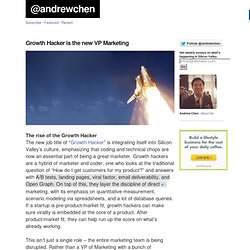

Video: Chamath Palihapitiya - how we put Facebook on the path to 1 billion. The Beginner's Guide to Conversion Rate Optimization. Download Guide: Drive Conversions: Share Guide: “One accurate measurement is worth more than a thousand expert opinions” – Admiral Grace Hopper The Beginner’s Guide to Conversion Rate Optimization (CRO) is an in-depth tutorial designed to help you convert more passive website visitors into active users that engage with your content or purchase your products.

This guide will walk you through the basics of CRO—from why it matters in the first place to how you can go about building your own testing and optimization plan. This is a guide to help you map your way through the common CRO pitfalls and misconceptions by starting from the ground up—making insight-driven changes and then testing them for efficacy every step of the way. First, a quick definition… CRO is the method of using analytics and user feedback to improve the performance of your website.
At its most fundamental, CRO means figuring out what users are looking for when they arrive at your site and then giving that to them. The top 20 most viral companies of the decade (and how they ultimately performed) By Bryan Goldberg On December 17, 2013 This list needs to exist.

Ever since the dawn of the Web 2.0 era, founders and investors have been mesmerized by the concept of “going viral” — the tantalizing prospect of sudden riches, hewn seemingly out of thin air. Upworthy — What Happens When a Growth Hacker Launches a Media Company. But how did they do it?

In part one of this analysis we break down how Upworthy grew from a political news engine into one of the world’s fastest growing media companies. In part two, we take a look at the risks to their model and dissect whether Upworthy will suffer the fate of other viral sensations driven off the back of Facebook, or if they’ve got an engine of sustainable growth that will make them the new model for successful media companies. According to Adam Mordecai, Upworthy’s Editor-at-Large, “Anyone who says they can make anything go viral is probably a snake oil salesman or really naive.” [2] Yet, on the surface at least, it seems like that’s what Upworthy does.
The company—founded by Eli Pariser of MoveOn, Peter Koechley of The Onion, and Chris Hughes of Facebook—uses attention-grabbing headlines to highlight meaningful videos, pictures, and stories, often making them go viral. Early Traction. How to Design Kickass Long Form Sales Pages. 75inShareinShare Know those sales pages that are really, really long?

They’re great, but they mostly suck. I mean the way they are usually implemented sucks. Long form sales pages have their place, and they work extremely well in many circumstances. Are Companies Too Obsessed With Growth? How To Measure Habits. 71 Things to A/B Test. Oftentimes the hardest part of A/B testing is determining what to test in the first place.

After having worked with thousands of customers who do A/B testing every day, one of the most common questions we still hear is, “Where do I begin?” Conveniently, website testing inherently generates more questions than it answers. Your first test can lead to a whole litany of follow-up tests and iterations. For when you’ve exhausted all of those, or if you’re just getting started, here are 71 ideas (some more serious than others…) for testing your website. Calls to Action Your website exists for visitors to take action: reading, purchasing, signing up, downloading, or sharing. Buy Now? Photo courtesy of The Optimizely Beer Club.Test different CTA hover states to make it more obvious that buttons are clickable and create a feel of interactivity on the page.Test different colors, shapes, and sizes for CTA buttons on your website.
What You Actually Need in Order to Hack Growth. Each week, DailyTekk connects you with leading experts on a given topic as part of our Understanding series. This week we are focusing on explaining growth hacking. Yesterday the experts explained real examples of growth hacking in action and today you’ll learn what it actually takes to hack growth. Stay tuned; tomorrow we’ll wrap the series by discussing the future of growth hacking.
Last week we focused on Gamification . Josh Elman: The short answer is you can’t really “hack” growth. Paul Rosania: Measurement, prioritization and speed. Sean Ellis: The number one requirement for effective, sustainable growth hacking is to start with a “must have” product experience. Benefits of Experiments - Analytics Help. If you have a website, you have activities that you want your visitors to complete (e.g., make a purchase, sign up for a newsletter) and/or metrics that you want to improve (e.g., revenue, visit duration, bounce rate).

With Content Experiments, you can test which version of a landing page results in the greatest improvement in conversions (i.e. completed activities that you measure as goals) or metric value. Defining A Growth Hacker: Building Growth Into Your Team. In this series titled “Defining a growth hacker,” I will be exploring the meaning and practical application of growth hacking through a number of interviews with prominent growth hackers.

This is the fourth post of the series. The previous posts are as follows: common characteristics here, growth hacking’s impact on marketing here, and impact on product here. Defining A Growth Hacker: Growth Is Not A Marketing Strategy. In this series titled “Defining a growth hacker,” I will be exploring the meaning and practical application of growth hacking through a number of interviews with prominent growth hackers.

This is the third post of the series on product. Defining A Growth Hacker: 5 Ways Growth Hackers Changed Marketing. In this series titled “Defining a growth hacker”, I am exploring the meaning and practical application of growth hacking through a number of interviews with prominent growth hackers.

This is the second post the series, which outlines the ways growth hacking changed marketing. You can find the first post, “Defining A Growth Hacker: Three Common Characteristics,” here. The Internet has been the most disruptive vehicle in modern memory, changing everything from the way we buy shoes to the way we connect with friends. The profession of marketing has no less transformed over the last two decades. As social platform adoption became prolific, growth hacking spawned and changed the way startups thought about marketing and growth. Defining A Growth Hacker: Three Common Characteristics. Growth Hacker is the new VP Marketing. The rise of the Growth Hacker The new job title of “Growth Hacker” is integrating itself into Silicon Valley’s culture, emphasizing that coding and technical chops are now an essential part of being a great marketer.

Growth hackers are a hybrid of marketer and coder, one who looks at the traditional question of “How do I get customers for my product?” And answers with A/B tests, landing pages, viral factor, email deliverability, and Open Graph. On top of this, they layer the discipline of direct3 marketing, with its emphasis on quantitative measurement, scenario modeling via spreadsheets, and a lot of database queries. Defining A Growth Hacker: Debunking The 6 Most Common Myths About Growth Hacking. In this series titled “Defining a growth hacker,” I explore the meaning and practical application of growth hacking through a number of interviews with prominent growth hackers. This is the fifth and final post in the series. The previous posts are as follows: common characteristics among growth hackers here, growth hacking’s impact on marketing here and product here, and how to build a growth into a team here. With any buzz, popular sentiment can become detached from reality.
Thought leaders in a burgeoning space can be blown up with grand expectations that can embellish the truth that lies underneath the surface. A Huge List Of Spam Comments which Looks Genuine. Spam blog comments is nothing new and many people uses mass commenting softwares which will help them to do a comment blast. At times, I get kind of comments which look so genuine that I find it difficult to unapprove it. Today, I got one such comments and seems like spammer forget to filter the comments and send out the complete list of spam comments. Here I’ sharing a list of such comments which look genuine and knowing them, you can easily distinguish them with genuine once. Though before we move ahead, here are some resources from the past which will help you to get more insight on Blog comments and commenting on Blog: How Does Google reward creativity?
An idea is born. The juices are flowing, and you can’t wait to unleash your newest Internet adventure. The marketing process starts with the first line of code. Correction: It starts before the first line of code. Combining great content, a diverse search engine optimization strategy, a creative website and many other aspects of online marketing is what brings success in the long run. But you’ve got to have the missing ingredient: Creativity. Google has an absolute spooky knack for finding quality on the Internet. People are always wondering… where does creativity come from?
For the SEO industry, creativity can come from many places, including: Industry involvementResearch, research, and more researchUsing real life examplesConstantly studying industry trendsLeveraging new informationTaking advantage of new technology (in the SEO space, being the first to use new Internet tools with high potential has many benefits)Developing content from common industry similaritiesCustom programming 1. 2.